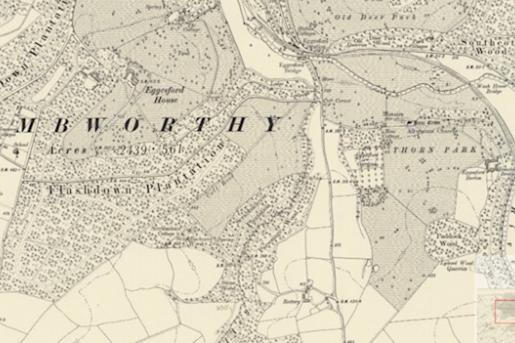- Parkland
The house built on a new site in 1822 by Thomas Lee, a Barnstaple architect, for Newton Fellowes. It was an early example in the county of an embattled Tudorstyle for a country house. It was dismantled in 1917. Now an eminently picturesque large ruin standing against the sky, surrounded by the woods of the Taw valley, like thebest of follies. Revd John Swete visited in 1796 and wrote that ‘the landscape had nothing in it of the wild, or romantic, it was a sweetly-pleasing picture, touched by the soft,
the minute, the elegant pencil of nature. Art did not seem to me to have used much of its interference in the embellishment of this little paradise.’ In 1806 Polwhele wrotethatit was ‘built about the year 1718 of brick, much increased and improved by the present possessor who has also laid out the grounds about it with much elegance and taste under the direction of the late Mr Richmond; woods well interspersed, considerable plantations and the river Taw contributing much to enrich and beautify the scene.’
White (1850) noted that ‘Old Eggesford House was the seat of the I.ords Chichester in the 17th century, and was rebuilt by W. Fellowes, Esq., in 1718, but was taken downabout 26 years ago. The present seat of the Hon. Newton Fellowes is a neat mansion, standing in the adjoining parish of Wembworthy. ’ Stockdale described it as ‘latelytaken down’. The sale particulars of 1913 particularly noted the walled kitchen gardens of three acres while that of 1914 noted the mile long drive and that the walks
were noted for the specimen trees. The Parkland survives. Within the former grounds are a nursery and garden.
For more details see the Eggesford House Report.
Cherry & Pevsner: The Buildings of England – Devon, 1989: 352,
T Gray: The Garden History of Devon,1995: 71,
T Gray: Devon Country Houses and Gardens Engraved Vol I, 2001: 109

